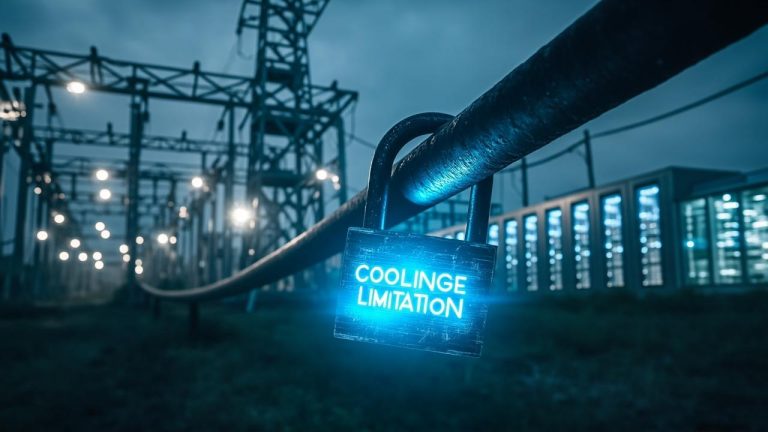Introduction
Data centers grappling with temperature imbalances find relief in rear door heat exchangers. Hot and cold aisles have long been a standard layout, but the reality is often far from ideal.
Inefficiently managed hot aisles are more than just an annoyance; they represent a significant drain on resources, leading to increased energy consumption as cooling systems struggle to keep pace. The consequences extend beyond utility bills, impacting equipment reliability, causing performance bottlenecks, and even creating localized hotspots that threaten critical hardware.
The persistent presence of hot aisles undermines data center efficiency and resilience. Servers operating in excessively warm environments are prone to premature failure, resulting in costly downtime and potential data loss. Moreover, inconsistent temperatures across the data center floor create a ripple effect, forcing cooling systems to work harder and consume more energy than necessary. This not only inflates operational expenses but also increases the data center’s carbon footprint, contributing to environmental concerns.
Effective hot aisle management offers a pathway to substantial cost savings, improved server uptime, and the ability to support higher densities of computing equipment. By implementing strategic cooling solutions and best practices, data centers can reclaim wasted energy, extend the lifespan of their hardware, and unlock additional capacity within their existing infrastructure. This guide provides actionable strategies for permanently eliminating hot aisles, paving the way for a more efficient, reliable, and sustainable data center environment.
Understanding the Physics
The existence of hot aisles is rooted in the fundamental physics of heat transfer. Servers and network equipment, the workhorses of any data center, consume significant amounts of electrical power. A large portion of this power is converted into heat as the components operate.
Processors, memory modules, power supplies, and hard drives all contribute to the overall heat load within a server chassis. As these components become more powerful and densely packed, the amount of heat generated within the same physical space increases exponentially.
Because hot air naturally rises and seeks areas of lower pressure, it tends to accumulate in the upper regions of the hot aisle, creating temperature gradients. These gradients mean that servers at the top of the racks often experience significantly higher intake temperatures than those at the bottom, leading to inconsistent performance and potential reliability issues.
The negative impacts of these overheated zones are multifold. Elevated temperatures can significantly reduce the lifespan of electronic components, leading to premature failures and costly replacements. Hotspots within the hot aisle can also trigger thermal throttling, where servers reduce their processing speed to prevent overheating, thereby impacting overall application performance.
Furthermore, the inefficient cooling required to combat poorly managed hot aisles leads to increased energy consumption and higher operating costs. Implementing technology, such as rear door heat exchangers, can assist in reducing these negative impacts.
The Obvious (And Often Overlooked) First Steps
Even before implementing advanced containment strategies or investing in cutting-edge cooling technologies, data centers can significantly improve their hot aisle situation by focusing on some fundamental best practices. These are the low-hanging fruit of data center optimization, often overlooked but incredibly effective in creating a more balanced thermal environment.
Simple changes in approach can yield disproportionately beneficial results, reducing the strain on existing cooling infrastructure and paving the way for more advanced cooling solutions in the future. These initial steps are essential for establishing a solid foundation for any comprehensive hot aisle elimination strategy.
One of the most effective, and surprisingly underutilized, methods for managing airflow is the proper installation of blanking panels. Empty rack spaces act as conduits for air to bypass equipment, disrupting the intended airflow patterns and contributing to hot spots. By sealing these gaps with blanking panels, you force air to flow through the servers as intended, ensuring more efficient cooling. Consider the different types of blanking panels available:
Furthermore, cable management plays a crucial role in mitigating hot aisles. A tangled mess of cables obstructs airflow and creates pockets of stagnant air. Clear and organized cabling allows for unrestricted movement of air, preventing heat build-up. Implementing a structured cabling system, using cable ties and trays, and ensuring cables are routed in a way that doesn’t block vents can make a substantial difference. Consider these cable management best practices:
Finally, sealing air leaks around racks and under raised floors prevents cool air from escaping and hot air from infiltrating the cold aisle. Identifying and sealing these leaks is a simple but impactful task. Utilize foam strips, caulk, or other sealing materials to close any gaps or openings.
A well-sealed environment ensures that the cooling system operates efficiently and effectively. Investing in this step will also maximize the efficiency of technologies such as rear door heat exchangers. Pay special attention to:
Containment Strategies
There are two primary approaches to containment: Cold Aisle Containment (CAC) and Hot Aisle Containment (HAC). CAC involves enclosing the cold aisle with walls, doors, and a ceiling, creating a contained space where cool air is supplied. The hot air is then allowed to exhaust into the surrounding data center space, where it is drawn back to the cooling units.
HAC, conversely, encloses the hot aisle, channeling hot exhaust air directly back to the cooling system. This approach allows the rest of the data center to function as a large cold aisle.
The choice between CAC and HAC depends on several factors, including existing infrastructure, budget, and desired outcomes.
Here’s a breakdown of considerations:
Regardless of the chosen approach, proper sealing is paramount. Gaps and leaks in the containment structure will compromise the effectiveness of the system, allowing hot and cold air to mix and negating the benefits of containment. Furthermore, proper airflow management within the contained area is crucial to ensure that servers receive an adequate supply of cool air. Some advanced solutions involve deploying rear door heat exchangers to further enhance the cooling process.
Leveraging Advanced Cooling Technologies
In-Row Cooling: Targeted Cooling Power
One strategy to combat hot aisles effectively is to move the cooling source closer to the heat source. In-row cooling units are designed to be placed directly within the server racks, drawing hot air from the aisle and expelling cooled air directly where it’s needed. This targeted approach significantly reduces the distance hot air travels, minimizing mixing with the cold aisle and improving overall cooling efficiency.
By addressing the heat load at its origin, in-row cooling offers a more responsive and efficient solution compared to relying solely on perimeter cooling. This method is especially beneficial in data centers with varying heat densities across different racks.

Harnessing the Power of Rear Door Heat Exchangers
For a more comprehensive solution, consider the implementation of rear door heat exchangers. These innovative devices replace the standard rear doors of server racks. They function by drawing the hot exhaust air directly from the servers through a heat exchanger, which then cools the air before it’s released back into the data center. This method prevents the hot air from ever entering the hot aisle in the first place, drastically reducing temperatures and improving cooling efficiency.
Rear door heat exchangers come in different types, including passive and active models. Passive units rely on natural convection and are suitable for lower-density environments, while active units utilize fans and pumps to enhance heat transfer, making them ideal for high-density deployments. The choice between active and passive depends on the specific cooling requirements and power constraints of the data center.
Exploring Liquid Cooling Options
As data centers continue to push the boundaries of compute density, traditional air-cooling methods may struggle to keep pace. Liquid cooling solutions offer a more efficient and direct way to remove heat from high-powered components. Direct-to-chip cooling involves circulating coolant directly over the processors and other heat-generating components within the server. This method provides exceptional cooling performance but requires specialized server designs and infrastructure.
Immersion cooling takes this concept a step further by submerging entire servers in a dielectric coolant. This approach offers the highest cooling capacity and is well-suited for extreme high-density deployments. Liquid cooling solutions, while initially more complex and expensive to implement, can provide significant long-term benefits in terms of energy efficiency and performance, particularly for demanding workloads like AI and machine learning.
Monitoring and Management
Effective monitoring and management are crucial for maintaining optimal data center conditions and preventing the resurgence of hot aisle issues. It’s not enough to simply implement cooling solutions; continuous oversight is required to ensure they are performing as expected and to identify any emerging problems.
Environmental monitoring systems form the backbone of this effort, relying on a network of strategically placed temperature and humidity sensors throughout the data center. These sensors provide real-time data on environmental conditions, allowing administrators to track temperature variations, identify hotspots, and assess the overall effectiveness of cooling strategies.
Setting appropriate thresholds and alerts within the monitoring system is paramount. These thresholds define acceptable temperature and humidity ranges, and when exceeded, trigger alerts that notify data center staff of potential issues. These alerts enable proactive intervention, preventing minor fluctuations from escalating into critical problems that could impact equipment performance or cause downtime.
Analyzing the collected data allows for optimization. It enables the identification of trends, such as gradual increases in temperature over time or recurring hotspots in specific areas. This information can then be used to fine-tune cooling strategies, adjust airflow patterns, and optimize the placement of equipment to maintain a consistent and stable environment.
DCIM software provides a centralized platform for comprehensive monitoring and control of the entire data center infrastructure. In addition to environmental monitoring, DCIM systems can track power consumption, asset utilization, and other critical parameters.
By integrating all of this data into a single interface, DCIM enables data center managers to gain a holistic view of their operations and make informed decisions to optimize performance, improve efficiency, and prevent problems. Leveraging this type of system in conjunction with the implementation of rear door heat exchangers can significantly enhance their effectiveness by giving you the tools needed to closely watch the changes in temperature after implementation.
| Monitoring Component | Function |
|---|---|
| Temperature Sensors | Real-time temperature data collection |
| Humidity Sensors | Real-time humidity data collection |
| Thresholds and Alerts | Notifications for temperature/humidity excursions |
| DCIM Software | Centralized monitoring, control, and reporting |
Case Studies
Organizations across diverse sectors have successfully tackled the persistent problem of hot aisles, reaping significant benefits in terms of energy efficiency, equipment reliability, and overall data center performance. Take, for example, a large financial institution struggling with chronic hotspots and escalating cooling costs. By implementing a combination of hot aisle containment and strategic deployment of blanking panels, they were able to create a more stable and efficient thermal environment.
This resulted in a measurable decrease in energy consumption, translating to substantial cost savings on their utility bills. Furthermore, the reduction in temperature fluctuations led to improved server stability and a decrease in hardware failures, enhancing the overall reliability of their critical IT infrastructure.
Another compelling example involves a research university that adopted a phased approach to hot aisle elimination. Initially, they focused on foundational best practices like cable management and sealing air leaks. They then introduced in-row cooling units to target hotspots in specific areas of the data center.
Finally, they installed rear door heat exchangers on high-density server racks. This combination of strategies enabled them to accommodate increasingly power-hungry research equipment without overwhelming their existing cooling infrastructure. The results were impressive, including a significant reduction in PUE (Power Usage Effectiveness) and a dramatic improvement in server uptime.
A final case study highlights a colocation provider that leveraged data center infrastructure management (DCIM) software to optimize their cooling strategies. By analyzing real-time temperature data and airflow patterns, they were able to identify and address inefficiencies in their cooling system. This enabled them to fine-tune their cooling settings, optimize fan speeds, and strategically relocate equipment to minimize hotspots.
The colocation provider also offered their clients the option of implementing hot aisle containment at the rack level for added security and thermal management. As a result, they were able to attract new clients seeking high-performance computing solutions and enhanced reliability, solidifying their position in the competitive colocation market.
| Case Study | Strategies Implemented | Measurable Results |
|---|---|---|
| Financial Institution | Hot Aisle Containment, Blanking Panels | Reduced Energy Consumption, Improved Server Stability, Decreased Hardware Failures |
| Research University | Cable Management, Air Leak Sealing, In-Row Cooling, Rear Door Heat Exchangers | Reduced PUE, Improved Server Uptime |
| Colocation Provider | DCIM Software, Optimized Cooling Settings, Rack-Level Hot Aisle Containment (Optional) | Attracted New Clients, Enhanced Reliability |
Future-Proofing Your Data Center
The data center landscape is in a constant state of flux, driven by relentless innovation in computing technologies. High-density computing, artificial intelligence (AI) workloads, and the Internet of Things (IoT) are all placing increasing demands on data center infrastructure, particularly cooling systems.

To effectively manage hot aisles and maintain optimal operating conditions, data centers must adopt future-proof strategies that can adapt to these evolving needs. A reactive approach to cooling is no longer sufficient; a proactive and flexible approach is essential.
Scalability and Flexibility in Cooling Solutions
Scalability and flexibility are paramount when selecting cooling solutions for the future. Data centers must be able to easily scale their cooling capacity to accommodate increasing heat loads without significant disruptions or costly overhauls. Modularity is a key factor, allowing for incremental additions of cooling units as needed. This approach avoids over-provisioning and ensures that cooling capacity aligns with actual demand.
Moreover, the chosen cooling solutions should be flexible enough to adapt to different rack densities and server configurations. For instance, a solution that works well for low-density racks may not be suitable for high-density deployments. This is where tools like rear door heat exchangers come into play, as they can be deployed on a per-rack basis to deal with high heat loads.
The Importance of Vendor Selection
Selecting the right vendor is critical for future-proofing data center cooling infrastructure. A reliable vendor should offer a comprehensive portfolio of cooling solutions, from traditional air cooling to advanced liquid cooling technologies.
They should also have a proven track record of innovation and a commitment to developing cutting-edge solutions that meet the evolving needs of the industry. It’s important to work with vendors that provide detailed product roadmaps, offering insights into future developments and ensuring that your cooling infrastructure remains up-to-date.
Consider vendors that offer comprehensive support services, including installation, maintenance, and remote monitoring. A strong vendor partnership can provide valuable expertise and guidance, helping you navigate the complexities of data center cooling and ensure long-term reliability and efficiency. Furthermore, ensure the vendor can help implement rear door heat exchangers.
AI and Machine Learning for Optimized Cooling
The integration of artificial intelligence (AI) and machine learning (ML) offers significant potential for optimizing data center cooling. AI-powered systems can analyze real-time data from temperature sensors, humidity sensors, and power meters to identify patterns and predict potential hotspots. This allows for proactive adjustments to cooling systems, ensuring that cooling resources are deployed efficiently and effectively.
ML algorithms can also learn from historical data to optimize cooling strategies over time, continuously improving energy efficiency and reducing operating costs. For example, AI can be used to dynamically adjust fan speeds, cooling unit setpoints, and airflow patterns based on real-time conditions. This level of automation can significantly reduce human intervention and improve the overall performance of the cooling infrastructure.
Conclusion
In conclusion, the journey to eliminate hot aisles is a multi-faceted one, demanding a blend of foundational best practices, strategic containment, and the intelligent application of advanced cooling technologies. From deploying simple blanking panels to implementing sophisticated monitoring systems, each step contributes to a more efficient and reliable data center.
The financial and operational advantages of a well-managed thermal environment are undeniable, paving the way for cost savings, enhanced server uptime, and the ability to support increasingly demanding workloads.
The strategies discussed, ranging from basic cable management to the implementation of cutting-edge solutions like rear door heat exchangers and liquid cooling, offer a comprehensive toolkit for addressing the persistently pesky problem of hot aisles. Real-world case studies demonstrate that success is achievable, regardless of the data center’s size or complexity.
By embracing these strategies and adapting them to specific needs, data center operators can effectively close the door on hot aisles, creating a cooler, more efficient, and more resilient environment.
Ultimately, the proactive management of hot aisles isn’t just about preventing overheating; it’s about optimizing the entire data center ecosystem for peak performance and long-term sustainability. Embrace the strategies outlined, adapt them to your specific needs, and witness the transformative impact on your data center’s efficiency, reliability, and overall operational excellence.
Take the first step towards a cooler, more efficient data center today – explore advanced cooling solutions or seek expert consultation to unlock the full potential of your infrastructure.
Frequently Asked Questions
What are rear door heat exchangers and what is their primary function?
Rear door heat exchangers are cooling devices designed to be mounted on the rear door of an enclosure, typically an electronics cabinet. Their primary function is to remove heat generated by the equipment inside the cabinet, maintaining optimal operating temperatures and preventing overheating that can lead to component failure and system downtime.
These exchangers circulate a cooling fluid to absorb and dissipate heat.
Where are rear door heat exchangers typically used and in what industries?
These heat exchangers are commonly used in data centers, telecommunications facilities, and industrial control systems where high-density computing and electronic equipment are housed. Industries that benefit from this technology include information technology, telecommunications, manufacturing, and any sector requiring reliable cooling of enclosed electronic components within a controlled environment. They provide a targeted cooling solution for critical hardware.
What are the key benefits of using rear door heat exchangers compared to traditional cooling methods?
Compared to traditional cooling methods like CRAC units, rear door heat exchangers offer several benefits. They provide more targeted cooling directly at the heat source, leading to greater energy efficiency. They also allow for higher density equipment deployment, minimizing space requirements, and they reduce the risk of hot spots within the enclosure, creating a more stable and predictable operating environment.
How do rear door heat exchangers work to dissipate heat from enclosed spaces?
Rear door heat exchangers work by using a closed-loop system. A cooling fluid, typically water or a refrigerant, circulates through a network of pipes and fins mounted on the rear door.
Hot air from inside the enclosure is drawn across the fins, transferring heat to the cooling fluid. The heated fluid is then circulated to a chiller or other cooling unit, where the heat is dissipated, and the cooled fluid is returned to the rear door to repeat the process.
What are the different types of rear door heat exchangers available and what are their specific applications?
There are several types of rear door heat exchangers available. Air-to-air heat exchangers utilize fans to circulate air across the heat sink and exhaust the hot air into the surrounding environment. Air-to-liquid heat exchangers use a liquid coolant to absorb the heat and transfer it to a remote chiller or cooling tower.
Direct expansion (DX) rear door coolers use a refrigerant that evaporates inside the unit, providing a high cooling capacity. Each type is selected based on the specific heat load, environmental conditions, and infrastructure constraints.




